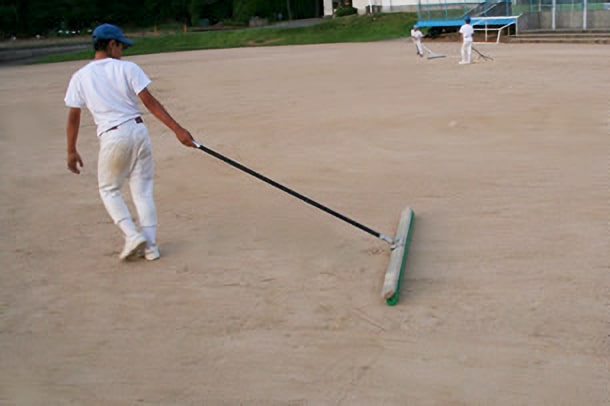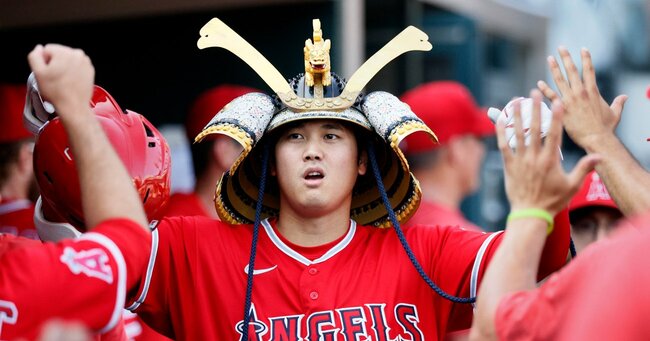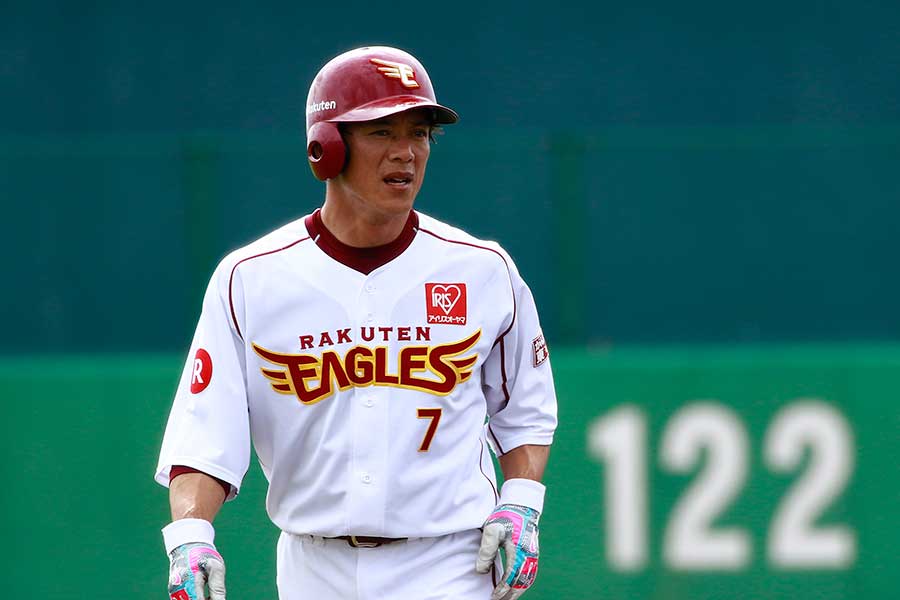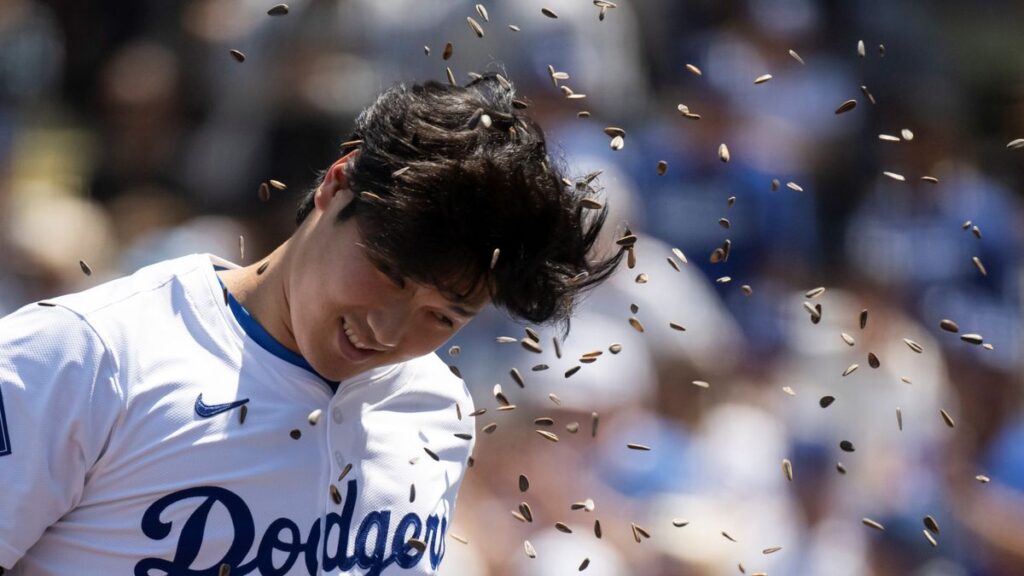
In baseball, the mound is a key factor in determining the flow of the game.
An accurate and solid mound is essential to maximizing a pitcher’s performance.
In this article, we will explain in detail the process, starting with the basic structure and function of a mound, and then going on to design and preparation, building the foundation, setting the height and slope, finishing the surface, and maintenance.
Plus, we’ll share advice from professional groundskeepers and offer tips for building a better mound.
目次
Basic structure and function of the mound
The baseball mound is a central and important element of the game.
Understanding its basic structure and role is essential to providing a better playing environment.
Here we explain in detail what a mound is and its importance.
What is a mound?
The mound is the raised earthen area in the center of the infield of a baseball stadium from which the pitcher delivers the ball.
At the top of the mound is the pitcher’s plate, from which the pitcher throws the ball.
Typically, the mound is about 10 inches high and about 18 feet in diameter.
The mound is sloped slightly all around, allowing the pitcher to throw the ball more steadily.
The angle of tilt is very important and if not designed properly it can throw the pitcher off balance and affect their performance.
Additionally, the quality of the soil on the mound is also important, with soil of the right hardness and softness being used to provide the right grip when the pitcher steps on it.
The Importance of the Mound
The mound plays several important roles in the game of baseball.
Improved Pitcher Performance
The height and slope of the mound help pitchers deliver more powerful and controlled pitches. The height allows pitchers to put more spin on the ball with the help of natural gravity as they deliver the ball. This increases the power of fastballs and curveballs, giving pitchers an advantage over hitters.
Keeping the Game Even A
properly maintained mound provides a fair playing environment for both teams. If the mound is in poor condition, the pitcher is at a disadvantage and the game is not even. Therefore, it is important to check the condition of the mound before the game and maintain it if necessary.
Injury Prevention
Pitchers perform extremely strenuous movements when pitching. A proper mound reduces the strain on the pitcher’s ankles, knees, and hips, and reduces the risk of injury. Especially at the professional level, the quality of the mound is very important because the health of the pitcher is directly linked to the performance of the team.
Strategic Elements
The characteristics of the mound also affect the team’s strategy. For example, a mound made of hard soil is advantageous for fastball pitchers, while soft soil is advantageous for curveball pitchers. This allows the home team to adjust the mound to suit the characteristics of their pitchers and gain an advantage in the game.
The mound plays a vital role in many aspects of a baseball game, including pitcher performance, balancing the game, preventing injuries, and being a strategic element.
Proper mound design and maintenance are essential to providing a good playing environment and enabling players to perform at their best.

Mound design and preparation
Proper design and preparation of a baseball mound is essential to the success of the game.
Here we will explain in detail the necessary materials and tools, and how to create and check blueprints.
Materials and tools needed
To create a mound, you will need the following materials and tools:
material :
- Special soil : The soil for the mound needs to have a good balance of hardness and softness. Clay is generally used to allow the pitcher to step on it with stability. Clay with the right amount of moisture is ideal.
- Crushed stone : Crushed stone is used for the foundation to ensure drainage. This allows water to drain well even during rainy weather, helping to maintain the mound in shape.
- Gravel : Putting gravel on top of the crushed stone helps prevent soil movement and increases the stability of the mound.
tool :
- Shovel and spade : Used to dig up and transport soil and crushed rock.
- Tupper : A tool used to compact soil, making the surface of the mound smooth and uniform in consistency.
- Level : Use a level to accurately measure the height and slope of the mound.
- A hose and spray nozzle : Use this to give the soil just the right amount of moisture. A spray nozzle is handy as it allows you to control the amount of water dispensed.
- Tape measure : Used to accurately measure the dimensions of the mound.
Creating and reviewing blueprints
It is important to create and review detailed blueprints before constructing the mound.
Please refer to the steps below:
1. Create a blueprint :
- Check the dimensions : Make sure the mound is about 10 inches tall and 18 feet in diameter. These dimensions are based on official MLB specifications, but check with your league’s regulations.
- Find the center point : Determine the exact center point of the mound and measure in each direction from there. Measure the radius from the center point to draw a circular mound.
- Slope Design : Design a gentle slope from the center of the mound to the outer edge, typically increasing one inch for every foot.
2. Check the blueprint :
- On-site inspection : We measure the actual site based on the design drawings to ensure that the dimensions are accurate. If there are any errors, we will revise the design drawings.
- Check ingredients : Make sure you have all the ingredients you need. If you are missing any, prepare them in advance.
- Prepare your tools : Make sure you have all the tools you will need and plan your work accordingly.
3. Markup :
- Marking the site : Using the design drawings, mark the location of the mound on site. Use spray paint or chalk lines to clearly define the boundaries of the mound.
- Redraw center lines : Draw lines from the center of the mound in each direction to show exactly where each piece is located.
Mound design and preparation is a critical process to ensure the game runs smoothly.
Create precise blueprints and gather the materials and tools you need to craft the mound where your pitcher can perform at his best.
Doing this process well can improve the quality of your baseball game.

Building the foundation of the mound
When building a baseball mound, laying the foundation is one of the most important steps.
Here we will explain in detail about leveling the ground, installing the foundation, drainage measures, and stabilizing the foundation.
Leveling the ground and laying the foundations
To build a mound, you first need to start by leveling the ground.
Grading is a critical process to ensure the stability and longevity of the mound.
Steps for leveling :
-
Clear the work area : Decide where to place the mound and remove any unnecessary obstacles or debris around it. A clear work area will allow you to work more efficiently.
-
Leveling the Ground : Use a shovel or spade to level the ground. Carefully level the ground so that the entire area where the mound will be placed is at an even height. Uneven ground can make the mound unstable and adversely affect play during the game.
-
Marking the foundation : Based on the design drawing, accurately mark the center point and boundaries of the mound, which will make it easier to install the foundation in the next step.
Foundation installation :
-
Laying the crushed stone : Once the ground is leveled, lay the crushed stone first. Crushed stone is ideal for the base of a mound because it has good drainage properties and will easily drain away water even during rain. Create a layer about 4 to 6 inches (about 10 to 15 centimeters) thick.
-
Add Gravel : Add gravel on top of the crushed stone. The gravel will help prevent the stone from shifting and provide an even more stable base. Aim for the gravel layer to be about 2 inches thick.
-
Compact the base : Use a tupper to compact the layer of crushed stone and gravel firmly. This ensures that the entire base compacts evenly and creates a strong base to support the mound superstructure.
Drainage measures and foundation stabilization
Even if the mound has a strong foundation, problems can arise during rainy weather if drainage measures are not taken.
Proper drainage measures are essential to the long-term stability of the mound.
Drainage measures :
-
Installation of drainage pipes : Rainwater can be effectively drained by installing drainage pipes around the mound. The drainage pipes are buried at an appropriate depth along the perimeter of the mound. This allows rainwater to drain quickly and not accumulate in the mound.
-
Drainage : Drains should be provided from the mound to the perimeter. The drains should be designed to take advantage of the natural slope of the ground to allow water to flow away. This will prevent rainwater from seeping into the base of the mound.
Stabilizing the foundation :
-
Laying a weed-proof sheet : Laying a weed-proof sheet on top of the foundation will prevent the intrusion of weeds. If weeds grow, they may damage the foundation of the mound, so the weed-proof sheet plays an important role.
-
Add a layer of clay : Add a layer of clay on top of the weed barrier. The clay is especially important because it provides stability for the pitcher when he steps on it. The clay layer should be about 6 inches thick and evenly distributed.
-
Final Leveling and Adjustment : Level the clay layer evenly and pack it firmly with a tapper. This ensures that the entire mound is smooth and stable. Finally, recheck the slope and height and make any necessary adjustments.
When building the foundation for a mound, it is important to carefully carry out each step of leveling the ground, installing the foundation, taking measures for drainage, and stabilizing the foundation.
This helps create a solid, stable mound on which pitchers can perform at their best.
By fully understanding this process and carrying it out properly, you can maintain a high quality mound for a long period of time.

Setting the height and slope of the mound
Because a baseball mound has a significant impact on a pitcher’s performance, it is important to set its height and slope accurately.
Here we will explain in detail the standards and measurement methods for mound height, as well as how to design and build the slope.
Height standards and measurement methods
The height of the mound directly affects the quality of a pitcher’s pitches.
Setting the correct height will allow the pitcher to throw the ball more effectively.
Height criteria :
- MLB Rules : Major League Baseball (MLB) rules state that the mound height is 10 inches above home plate. This standard is consistent at all professional levels.
- Amateur league regulations : Amateur leagues and student baseball often follow MLB standards, but there may be slight differences depending on the league or region. It is important to check the regulations in advance.
Measuring method :
- Set your reference point : Start with the center of home plate and measure the exact distance from there to the center of the mound. In MLB, this distance is 60 feet, 6 inches (approximately 18.44 meters).
- Height Measurement : Using a laser level or level, measure the height from home plate to the top of the mound. Adjust it so that the top of the mound is exactly 10 inches high.
- Check and Adjust : Take multiple measurements to ensure the mound is a uniform height. Add or remove soil as needed to maintain the exact height.
How to design and build a slope
The slope of the mound must be designed to allow the pitcher to throw the ball with stability.
Proper inclination reduces strain on the pitcher’s body and reduces the risk of injury.
Tilt criteria :
- MLB Rules : MLB rules state that the ideal slope for the mound should be one inch for every foot from the center of the mound toward home plate, allowing the pitcher to use gravity to help smooth out his throwing motion.
Tilt design :
- Set Center Point : Sets the slope radially from the center point of the mound. Creates a slope with a radius of 18 feet from the center point.
- Measuring height : Measure the height at each point and adjust it according to the standard for an even descent. Using a laser level can help you design an accurate slope.
How to create a slope :
- Soil placement : Place the soil evenly from the center of the mound to the periphery according to the design. Create a smooth slope by gradually reducing the amount of soil from the center to the periphery.
- Leveling and Compacting : Use a shovel or spade to level the soil evenly. Use a tupper to compact the soil firmly to create a smooth, stable slope.
- Check and Adjust : Finally, check the entire slope again and make any necessary adjustments to ensure it is even and smooth, allowing the pitcher a comfortable experience while throwing.
The height and slope of the mound greatly affect the quality of a baseball game.
By setting the correct height and incline, you can provide the pitcher with the environment they need to perform at their best.
By carrying out this process carefully, we can maintain a high quality mound for a long period of time.

Mound surface finishing
The surface of a baseball mound is a key factor in allowing a pitcher to play consistently.
This article will explain in detail how to level and level the surface, choose the best soil and how to place it.
Surface leveling and uniformity
Leveling and uniforming the surface of the mound is essential for pitchers to be able to throw the ball consistently.
Follow the steps below to level the ground properly.
Surface preparation steps :
-
Initial preparation : After the foundation of the mound is complete, start preparing the surface. Use a shovel or spade to remove any rough irregularities. At this stage, care should be taken to ensure that the soil is evenly distributed.
-
Fine adjustment : After the rough leveling is complete, use a tapper or rake to make fine adjustments. It is especially important to pack the area around the pitcher’s plate firmly. Level carefully to make the surface smooth and even.
-
Moisture control : Adding the right amount of moisture while preparing the soil will help the soil compact evenly. Use a hose and spray nozzle to lightly water the surface as you work. Add a little at a time, as too much water will make the soil muddy and difficult to work with.
-
Final check : Check the height again with the spirit level to ensure the surface is even and smooth. Any uneven areas are re-leveled for a perfect finish.
How to choose the best soil and how to arrange it
The choice of soil for the mound surface directly impacts a pitcher’s performance.
Use the following points as a guide to choose the best soil and place it properly.
How to choose the best soil :
-
Clay : Clay soil is the best surface for a mound. It has a good balance of hardness and flexibility, and provides a good grip for the pitcher to step on. Soils with a high clay content are used, especially in the MLB.
-
Adjust the soil size : The soil size should be medium to coarse. This will provide a stable surface while still allowing adequate drainage. Avoid soil that is too fine as it will not drain well and may cause problems during rainy weather.
-
Check the quality : Check the quality of the soil you are buying to ensure it has a consistent grain size and consistency. Buying from a reliable source will ensure you get consistent quality soil.
How to place the soil :
-
Initial placement : Place a moderate amount of soil evenly over the surface of the mound. At this stage, you should spread the soil about 2 to 3 inches thick. Be careful to place it evenly over the surface.
-
Adjust the moisture : After placing the soil, add water again and use a Tupperware container to firm the soil. By distributing the moisture evenly, the soil will firm up and form a stable surface.
-
Final preparation : Use a rake to prepare the surface so it is smooth and even. It is important to compact the surface well, especially the area where the pitcher will stand.
-
Regular maintenance : Depending on the frequency of use, perform regular maintenance on the surface. To prevent dents caused by pitchers stepping on the surface or soil erosion, regularly level the surface, add moisture and re-compact it.
The surface finish of the mound is a key factor in allowing pitchers to perform at their best.
Proper preparation, soil selection and placement will provide a stable mound and improve the quality of the game.
By carrying out this process carefully, we can maintain a high quality mound for a long period of time.

Mound Maintenance
The baseball mound plays a very important role in the game.
With proper maintenance, you can keep the mound in top condition and maximize your pitcher’s performance.
Here we will explain in detail the importance of regular maintenance as well as specific maintenance methods and schedules.
The Importance of Regular Maintenance
The mound is one of the most heavily used surfaces during a game, with pitchers stepping on it every time, often causing the surface to become dented and the soil to wash away.
Neglecting regular maintenance can result in the following problems:
Decreased Pitcher Performance : An uneven mound negatively impacts a pitcher’s throwing motion. Irregularities make it harder for a pitcher to step on the mound, causing them to lose their balance. This can lead to poor control and reduced accuracy and velocity.
Increased risk of injury : An improper mound increases the risk of injury for pitchers. It can put excessive strain on the ankles, knees, and hips, which can lead to breakdowns. Regular maintenance is essential to reduce these risks.
Ensuring fairness in the game : Poor condition of the mound can affect the fairness of the game. It is important to keep the mound in good condition at all times to avoid giving the home team an advantage or disadvantage.
Specific maintenance methods and schedules
Regular maintenance is essential to keeping your mound in top condition.
The specific maintenance methods and schedules are shown below.
Daily maintenance :
-
Leveling the ground after the game : Immediately after the game, the surface of the mound is leveled. Use a shovel or rake to fill in any dents and spread the soil evenly. Pay particular attention to leveling the area around the pitcher’s plate.
-
Moisture : After preparing the soil, add an appropriate amount of moisture to the surface. Use a hose and spray nozzle to water evenly and keep the soil from drying out. Maintaining adequate moisture helps the soil to compact.
Weekly maintenance :
-
Deep leveling : Once a week, deep level the entire mound, not just the surface. This will allow the soil below the surface to compact evenly and remain stable for a long time.
-
Adding soil : Depending on how often the pitcher uses the pitcher, add new soil to any areas where the soil has thinned. The area around the pitcher’s plate and sloped areas will require frequent replenishment of soil.
Monthly maintenance :
-
Comprehensive inspection : Once a month, we will comprehensively inspect the condition of the entire mound. We will check that the height and slope are within the standards and make corrections if necessary. We will measure accurately using a laser level and spirit level.
-
Drainage check : We check the condition of drainage pipes and drains to see if they are clogged or deteriorated. We make sure that drainage is working properly and fix any problems as soon as possible.
Seasonal maintenance :
-
Off-season maintenance : After the season ends, we carry out extensive maintenance on the entire mound. We check the foundations and make major repairs if necessary. By maintaining the mound properly during this time, we can prepare for the next season in the best possible condition.
-
Complete soil replacement : During the off-season, consider replacing the entire soil on the mound. Adding new soil resets the mound for the next season and keeps it in ideal conditions for pitchers.
Mound maintenance is an important task that supports a pitcher’s performance.
Regular and planned maintenance will keep the stadium in top condition and improve the quality of your matches.
Follow this process carefully to maintain a high quality mound.

Expert advice on mound building




